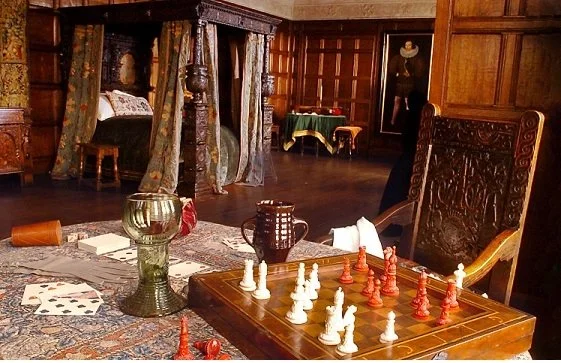Gaming and Game Boards
Our collection here at Agecroft houses some impressive examples of board games spanning the centuries from the mid-1500s to the early 1900s. It is not unusual that these items are present in our collections, however, as board games played an important role in society for much of common history.
An especially interesting piece, now on view in the Great Hall, is a hinged, double-sided game board that features a highly decorative chess board on one side and, when opened up, a backgammon, or tables, board. Checkers, or draughts, can also be played on this board. This board is a personal game board, with the original owner’s name, Casper Von Schlandersberg, a coat of arms, and the year 1558, depicted in marquetry on the side opposite the chess board. This beautifully crafted cherry wood piece is not only representative of Elizabethan and Stuart era recreation, but also social history during that time.
Scholars have not yet managed to pinpoint the origins of chess—some argue it was first played in Asia and what is modern-day Iraq for thousands of years before it ever found its way to Europe, as the term “chess” comes from the Persian word “shad” meaning king. Chess was introduced to England sometime in the 11th century, possibly through trade with Scandinavia or Spain. Backgammon has a similarly long history that also began in Asia before slowly making its way to Spain via trade with the Arabs in the 13th century.
Games such as backgammon and chess were used to teach children, particularly aristocratic and royal children, political strategy. Queen Elizabeth I and King Charles I enjoyed chess whereas King James I preferred backgammon. In his treatise, A Kinge’s Christain Dutie Toward God, James I wrote “…I will not therefore agree with the curiositie of some learned men of our age in forbidding cardes, dice and such like the games of hazard; when it is foule and stormie weather, then I say, may ye lawfully play at cardes and tables.”
Professional gaming was legalized during the Stuart dynasty in England and many aristocrats used it as a regular source of income. The Protestant faction claimed it was causing moral corruption amongst the elites in society because women were now included in gameplay and board games were created specifically for children as well. Specific games became representative of key traits and personalities and were used in popular literature to reveal a character’s psychological and social characteristics. For example, a penchant for status-seeking as a result of insecurity about one’s birth right may be present in someone who prefers a specific board game, while another game could indicate someone is prone to aggressive or violent outbursts.
While the family who lived at Agecroft during this time was certainly part of the upper class of Lancashire, they were far removed from the fancies of life in the Stuart Court and may well have adhered more closely to agrarian traditions surrounding games, which more or less match up with our own present day experiences of games as pastimes. Please come visit us and take a tour to see our beautiful 16th century game board!

